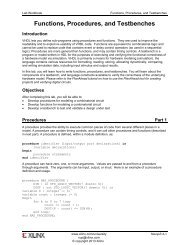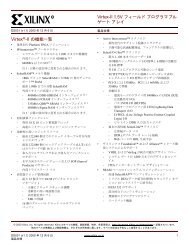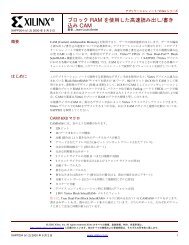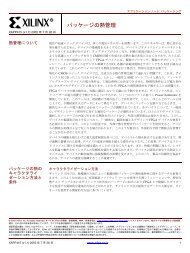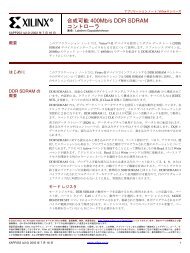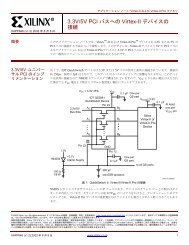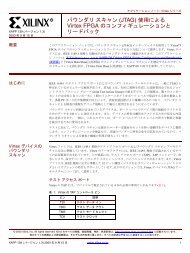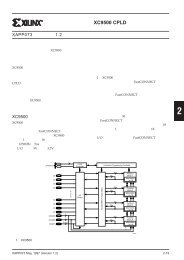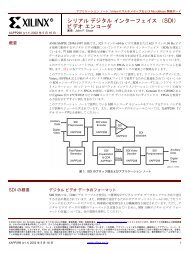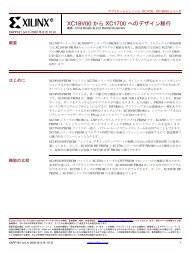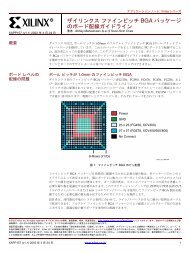- Page 1 and 2: System Generator for DSP Reference
- Page 3 and 4: Table of Contents Chapter 1: Xilinx
- Page 5 and 6: Block Parameters Dialog Box. . . .
- Page 7 and 8: DSP48E . . . . . . . . . . . . . .
- Page 9 and 10: Block Interface . . . . . . . . . .
- Page 11 and 12: Device Support . . . . . . . . . .
- Page 13 and 14: See Also . . . . . . . . . . . . .
- Page 15 and 16: Data Format . . . . . . . . . . . .
- Page 17 and 18: See Also . . . . . . . . . . . . .
- Page 19 and 20: Xilinx Blockset Chapter 1 Organizat
- Page 21 and 22: AXI4 Blocks Table 1-1: AXI4 Blocks
- Page 23: Table 1-2: Basic Element Blocks Blo
- Page 27 and 28: Data Type Blocks Table 1-4: Control
- Page 29 and 30: Table 1-6: DSP Blocks DSP Block Des
- Page 31 and 32: Table 1-7: Floating-Point Blocks In
- Page 33 and 34: Table 1-8: Index Blocks Index Block
- Page 35 and 36: Table 1-8: Index Blocks Index Block
- Page 37 and 38: Table 1-8: Index Blocks Index Block
- Page 39 and 40: Table 1-8: Index Blocks Index Block
- Page 41 and 42: Math Blocks Table 1-9: Math Blocks
- Page 43 and 44: Memory Blocks Table 1-10: Memory Bl
- Page 45 and 46: Table 1-12: Tool Blocks Tool Blocks
- Page 47 and 48: Common Options in Block Parameter D
- Page 49 and 50: Sample Period Common Options in Blo
- Page 51 and 52: Block Reference Pages Block Referen
- Page 53 and 54: Device Support Floating-Point suppo
- Page 55 and 56: LogiCORE Documentation Device Suppo
- Page 57 and 58: Block Parameters Basic tab Addressa
- Page 59 and 60: Refer to the section Overflow and Q
- Page 61 and 62: Assert Other parameters used by thi
- Page 63 and 64: AXI FIFO Block Interface Block Para
- Page 65 and 66: LogiCORE Documentation Device Suppo
- Page 67 and 68: Slice Repeat output_var = {port_ide
- Page 69 and 70: Black Box Black Box This block is l
- Page 71 and 72: Black Box can usually be used witho
- Page 73 and 74: Block Parameters Basic tab Black Bo
- Page 75 and 76:
An Example Black Box The following
- Page 77 and 78:
ChipScope ChipScope This block is l
- Page 79 and 80:
Known Issues More Information ChipS
- Page 81 and 82:
Implementation tab CIC Compiler 2.0
- Page 83 and 84:
CIC Compiler 3.0 Number of Stages:
- Page 85 and 86:
Clock Enable Probe Clock Enable Pro
- Page 87 and 88:
Clock Probe Clock Probe This block
- Page 89 and 90:
Signed (2’s comp): The output is
- Page 91 and 92:
Complex Multiplier 3.1 Optional Por
- Page 93 and 94:
Page 2 tab Output Product Range Com
- Page 95 and 96:
Complex Multiplier 5.0 System Gener
- Page 97 and 98:
Concat Block Interface Block Parame
- Page 99 and 100:
Block Parameters The dialog box for
- Page 101 and 102:
Constant Floating-point Precision -
- Page 103 and 104:
Convert Block Parameters Convert Th
- Page 105 and 106:
Convolution Encoder 7.0 Convolution
- Page 107 and 108:
Convolution Encoder 8.0 Convolution
- Page 109 and 110:
CORDIC 4.0 CORDIC 4.0 This block is
- Page 111 and 112:
CORDIC 4.0 Precision: Configures t
- Page 113 and 114:
y_in to cartesian_tdata_imag phase
- Page 115 and 116:
CORDIC 5.0 Precision: Configures t
- Page 117 and 118:
Counter Counter This block is liste
- Page 119 and 120:
DDS Compiler 4.0 DDS Compiler 4.0 T
- Page 121 and 122:
DDS Compiler 4.0 phase_in: used wh
- Page 123 and 124:
DDS Compiler 4.0 rfd: When checked
- Page 125 and 126:
DDS Compiler 5.0 When set to stream
- Page 127 and 128:
Implementation tab DDS Compiler 5.0
- Page 129 and 130:
Phase Offset Angles tab DDS Compile
- Page 131 and 132:
Delay Block Parameters System Gener
- Page 133 and 134:
cascaded, albeit without using the
- Page 135 and 136:
System Generator for DSP Reference
- Page 137 and 138:
Depuncture Depuncture This block is
- Page 139 and 140:
Disregard Subsystem Disregard Subsy
- Page 141 and 142:
OR_all_TLASTS: Pass the logical OR
- Page 143 and 144:
Divider Generator 3.0 latency: Thi
- Page 145 and 146:
AXI Interface AXI behavior: NonBlo
- Page 147 and 148:
Down Sample Down Sample This block
- Page 149 and 150:
Block Parameters Basic tab Xilinx L
- Page 151 and 152:
DSP48 Provide BCOUT port: when sel
- Page 153 and 154:
DSP48 Macro Block Interface Block P
- Page 155 and 156:
DSP48 Macro Consider the simple mod
- Page 157 and 158:
Reserved Port Identifier Opmode Sel
- Page 159 and 160:
DSP48 Macro Pseudo Opmode P=+C+P+Ci
- Page 161 and 162:
External Registers DSP48 Macro This
- Page 163 and 164:
DSP48 macro 2.0 Individual register
- Page 165 and 166:
DSP48 macro 2.0 1. Make sure that i
- Page 167 and 168:
DSP48 Macro 2.1 Block Parameters DS
- Page 169 and 170:
DSP48 Macro 2.1 shown below. Notice
- Page 171 and 172:
DSP48 Macro 2.1 You can find the ab
- Page 173 and 174:
DSP48A Provide PCOUT port: when se
- Page 175 and 176:
DSP48E Block Parameters Basic tab D
- Page 177 and 178:
DSP48E carryout. When the mode of o
- Page 179 and 180:
See Also Implementation DSP48E Para
- Page 181 and 182:
DSP48E1 subtracter in the adder/sub
- Page 183 and 184:
DSP48E1 Length of acout pipeline:
- Page 185 and 186:
Dual Port RAM Block Interface Dual
- Page 187 and 188:
Collision Behavior The result of si
- Page 189 and 190:
Xilinx LogiCORE Dual Port RAM This
- Page 191 and 192:
EDK Processor EDK Processor This bl
- Page 193 and 194:
Advanced tab Parameters specific to
- Page 195 and 196:
Expression Block Parameters Express
- Page 197 and 198:
Output Signals: Fast Fourier Transf
- Page 199 and 200:
Basic tab Fast Fourier Transform 7.
- Page 201 and 202:
Virtex-7, Kintex-7, Virtex-6, Spart
- Page 203 and 204:
Block Parameters Fast Fourier Trans
- Page 205 and 206:
Fast Fourier Transform 8.0 Display
- Page 207 and 208:
Data path and control signals: Fast
- Page 209 and 210:
FDATool Example of Use FDA Tool Int
- Page 211 and 212:
System Generator for DSP Reference
- Page 213 and 214:
FIR Compiler 5.0 coef_we: Used for
- Page 215 and 216:
FIR Compiler 5.0 The figure below s
- Page 217 and 218:
Number of paths: Specifies the numb
- Page 219 and 220:
FIR Compiler 6.2 FIR Compiler 6.2 T
- Page 221 and 222:
FIR Compiler 6.2 The output pins of
- Page 223 and 224:
FIR Compiler 6.2 User_Field: In th
- Page 225 and 226:
FIR Compiler 6.2 Both FIR Compiler
- Page 227 and 228:
FIR Compiler 6.2 The figure below s
- Page 229 and 230:
Filter Specification Filter Type:
- Page 231 and 232:
Implementation tab FIR Compiler 6.3
- Page 233 and 234:
Interface tab FIR Compiler 6.3 Data
- Page 235 and 236:
FIR Compiler 6.3 The figure below s
- Page 237 and 238:
From FIFO Block Parameters From FIF
- Page 239 and 240:
Output tab Output Type From FIFO S
- Page 241 and 242:
Binary point: position of the binar
- Page 243 and 244:
Gateway In Binary point: specifies
- Page 245 and 246:
System Generator Data Type Simulink
- Page 247 and 248:
Interleaver/De-interleaver 6.0 Inte
- Page 249 and 250:
Block Parameters Interleaver/De-int
- Page 251 and 252:
Interleaver/De-interleaver 6.0 Num
- Page 253 and 254:
Port Parameters tab Interleaver/De-
- Page 255 and 256:
Interleaver/De-interleaver 6.0 To a
- Page 257 and 258:
Device Support Virtex-7 and Kintex-
- Page 259 and 260:
Interleaver/De-interleaver 7.0 Alth
- Page 261 and 262:
AXI Interface Interleaver/De-interl
- Page 263 and 264:
Block Parameters Interleaver/De-int
- Page 265 and 266:
Rectangular Parameters #2 Tab Param
- Page 267 and 268:
Interleaver/De-interleaver 7.1 Inte
- Page 269 and 270:
Configuration Swapping Interleaver/
- Page 271 and 272:
Control Channel Input Signals: Inte
- Page 273 and 274:
COE File: The branch lengths are sp
- Page 275 and 276:
Interleaver/De-interleaver 7.1 ARE
- Page 277 and 278:
JTAG Co-Simulation Block Parameters
- Page 279 and 280:
Software tab JTAG Co-Simulation Par
- Page 281 and 282:
LFSR Feedback polynomial: This fie
- Page 283 and 284:
MCode MCode This block is listed in
- Page 285 and 286:
Relational operators: < Less than
- Page 287 and 288:
Constant Expressions MCode An expre
- Page 289 and 290:
Slice Function: xl_slice MCode Func
- Page 291 and 292:
MCode A method of a vector that que
- Page 293 and 294:
'b = ', num2str(b), ', ', ... 'x =
- Page 295 and 296:
FOR Loop FOR statement is fully unr
- Page 297 and 298:
MCode During the Simulink simulatio
- Page 299 and 300:
The following figure shows the bloc
- Page 301 and 302:
MCode The following M-code will als
- Page 303 and 304:
Pipelining Combinational Logic MCod
- Page 305 and 306:
ModelSim Block Parameters ModelSim
- Page 307 and 308:
Fine Points ModelSim The time scale
- Page 309 and 310:
ModelSim time scales. The actual de
- Page 311 and 312:
data type you select does not requi
- Page 313 and 314:
Multiple Subsystem Generator There
- Page 315 and 316:
domain_b_ce: in std_logic := '1'; d
- Page 317 and 318:
Mux Block Parameters This block is
- Page 319 and 320:
Natural Logarithm Natural Logarithm
- Page 321 and 322:
Network-based Ethernet Co-Simulatio
- Page 323 and 324:
Opmode Block Parameters Opmode This
- Page 325 and 326:
DSP48A Control Instruction Format D
- Page 327 and 328:
Instruction Field Name Carry In op[
- Page 329 and 330:
DSP48E1 Control Instruction Format
- Page 331 and 332:
Instruction Field Name Location Mne
- Page 333 and 334:
Pause Simulation Block Parameters P
- Page 335 and 336:
PicoBlaze Microcontroller Block Int
- Page 337 and 338:
PicoBlaze6 Instruction Display Bloc
- Page 339 and 340:
Block Interface Signal Direction De
- Page 341 and 342:
Device Support Supported PicoBlaze6
- Page 343 and 344:
Point-to-point Ethernet Co-Simulati
- Page 345 and 346:
Puncture Block Parameters Puncture
- Page 347 and 348:
Reciprocal SquareRoot Block Paramet
- Page 349 and 350:
Block Parameters Reed-Solomon Decod
- Page 351 and 352:
Reed-Solomon Decoder 7.1 Symbols P
- Page 353 and 354:
Reed-Solomon Decoder 8.0 Reed-Solom
- Page 355 and 356:
Reed-Solomon Decoder 8.0 event_s_c
- Page 357 and 358:
Attributes 2 tab Reed-Solomon Decod
- Page 359 and 360:
Reed-Solomon Encoder 7.1 Block Inte
- Page 361 and 362:
Block Parameters Reed-Solomon Encod
- Page 363 and 364:
Reed-Solomon Encoder 7.1 This is a
- Page 365 and 366:
Block Interface Channels and Pins R
- Page 367 and 368:
Reed-Solomon Encoder 8.0 Symbol wi
- Page 369 and 370:
Register Block Interface Block Para
- Page 371 and 372:
LogiCORE Documentation Device Suppo
- Page 373 and 374:
Reset Generator Block Parameters Re
- Page 375 and 376:
Resource Estimator hardware (except
- Page 377 and 378:
Resource Estimator design that is n
- Page 379 and 380:
System Generator for DSP Reference
- Page 381 and 382:
Register Block Interface Block Para
- Page 383 and 384:
Scale Block Parameters Xilinx LogiC
- Page 385 and 386:
Shared Memory Block Interface Share
- Page 387 and 388:
Block Parameters Basic tab Shared M
- Page 389 and 390:
Shared Memory Read FIFO Transaction
- Page 391 and 392:
Shared Memory Write FIFO Transactio
- Page 393 and 394:
Shift Block Parameters Xilinx LogiC
- Page 395 and 396:
Block Parameters Simulation Multipl
- Page 397 and 398:
Write Modes Single Port RAM Provid
- Page 399 and 400:
Xilinx LogiCORE Single Port RAM The
- Page 401 and 402:
Single-Step Simulation Block Parame
- Page 403 and 404:
SquareRoot Block Parameters Basic t
- Page 405 and 406:
System Generator Create interface
- Page 407 and 408:
c. Observe the elements in the gene
- Page 409 and 410:
System Generator Block icon displa
- Page 411 and 412:
Threshold Block Parameters Xilinx L
- Page 413 and 414:
Block Parameters Time Division Demu
- Page 415 and 416:
To FIFO Block Parameters To FIFO Th
- Page 417 and 418:
Output tab Output Type To FIFO Spe
- Page 419 and 420:
Output tab Specify explicit output
- Page 421 and 422:
Toolbar Block Interface Toolbar Thi
- Page 423 and 424:
Up Sample Block Interface Up Sample
- Page 425 and 426:
VDMA Interface 4.0 VDMA Interface 4
- Page 427 and 428:
X-Ref Target - Figure 1-5 X-Ref Tar
- Page 429 and 430:
VDMA Interface 4.0 AXI VDMA registe
- Page 431 and 432:
Block Parameters Basic tab VDMA Int
- Page 433 and 434:
VDMA Interface 5.4 VDMA Interface 5
- Page 435 and 436:
Block Parameters Basic tab VDMA Int
- Page 437 and 438:
Viterbi Decoder 7.0 Block Interface
- Page 439 and 440:
Viterbi Decoder 7.0 Best State Use
- Page 441 and 442:
Page7 tab Synchronization Options V
- Page 443 and 444:
Viterbi Decoder 8.0 Block Interface
- Page 445 and 446:
data points. The delay equals the d
- Page 447 and 448:
Viterbi Decoder 8.0 Best State Use
- Page 449 and 450:
LogiCORE Documentation Device Suppo
- Page 451 and 452:
WaveScope automatically updates. Yo
- Page 453 and 454:
Block Interface WaveScope Cursor >
- Page 455 and 456:
WaveScope A logic signal will, by d
- Page 457 and 458:
The Grid WaveScope Displaying the G
- Page 459 and 460:
Move Cursor Next WaveScope This opt
- Page 461 and 462:
Xilinx Reference Blockset Communica
- Page 463 and 464:
2 Channel Decimate by 2 MAC FIR Fil
- Page 465 and 466:
2n-tap Linear Phase MAC FIR Filter
- Page 467 and 468:
4-channel 8-tap Transpose FIR Filte
- Page 469 and 470:
5x5Filter tab. 5x5Filter The Xilinx
- Page 471 and 472:
BPSK AWGN Channel Block Parameters
- Page 473 and 474:
Block Parameters Reference CIC Filt
- Page 475 and 476:
Block Interface Block Parameters Co
- Page 477 and 478:
CORDIC DIVIDER Block Parameters Ref
- Page 479 and 480:
Reference CORDIC LOG 1. J. E. Volde
- Page 481 and 482:
CORDIC SQRT Block Parameters CORDIC
- Page 483 and 484:
Dual Port Memory Interpolation MAC
- Page 485 and 486:
m-channel n-tap Transpose FIR Filte
- Page 487 and 488:
Example Block Parameters Mealy Stat
- Page 489 and 490:
Mealy State Machine The following t
- Page 491 and 492:
Example Moore State Machine Conside
- Page 493 and 494:
Multipath Fading Channel Model Theo
- Page 495 and 496:
Functions Multipath Fading Channel
- Page 497 and 498:
Input Multipath Fading Channel Mode
- Page 499 and 500:
Reference Multipath Fading Channel
- Page 501 and 502:
n-tap MAC FIR Filter Block Paramete
- Page 503 and 504:
Example Registered Mealy State Mach
- Page 505 and 506:
Registered Moore State Machine Regi
- Page 507 and 508:
Block Parameters Registered Moore S
- Page 509 and 510:
Virtex2 Line Buffer Block Parameter
- Page 511 and 512:
White Gaussian Noise Generator Whit
- Page 513 and 514:
Xilinx XtremeDSP Kit Blockset Block
- Page 515 and 516:
XtremeDSP Co-Simulation Block Param
- Page 517 and 518:
XtremeDSP Digital to Analog Convert
- Page 519 and 520:
XtremeDSP LED Flasher Block Paramet
- Page 521 and 522:
System Generator Utilities xlAddTer
- Page 523 and 524:
xlAddTerms Syntax Description xlAdd
- Page 525 and 526:
Examples Remarks See Also optionStr
- Page 527 and 528:
See Also xlCache [maxentries] = xlC
- Page 529 and 530:
xlfda_denominator Syntax Descriptio
- Page 531 and 532:
xlGenerateButton Syntax Description
- Page 533 and 534:
xlgetparam and xlsetparam When xlse
- Page 535 and 536:
See Also directory: './bitstream' t
- Page 537 and 538:
See Also Example To illustrate how
- Page 539 and 540:
xlLoadChipScopeData Syntax Descript
- Page 541 and 542:
xlSBDBuilder JTAG Options: System G
- Page 543 and 544:
xlSetNonMemMap Syntax Description E
- Page 545 and 546:
xlSwitchLibrary Syntax Description
- Page 547 and 548:
Field Names Description [Default va
- Page 549 and 550:
Remarks See Also xlTBUtils The acti
- Page 551 and 552:
xlUpdateModel Syntax Description xl
- Page 553 and 554:
Examples Example 1: >> xlUpdateMode
- Page 555 and 556:
xlVersion Syntax Description See Al
- Page 557 and 558:
System Generator GUI Utilities Chap
- Page 559 and 560:
Xilinx BlockAdd As shown below, to
- Page 561 and 562:
Xilinx BlockConnect Simple Connecti
- Page 563 and 564:
Xilinx Tools > Terminate How to Use
- Page 565 and 566:
Verifying Input Port Data Type Requ
- Page 567 and 568:
Programmatic Access System Generato
- Page 569 and 570:
xInport xOutport System Generator A
- Page 571 and 572:
System Generator API for Programmat
- Page 573 and 574:
PG API Examples Hello World PG API
- Page 575 and 576:
MACC in a Masked Subsystem PG API E
- Page 577 and 578:
You’ll get the following subsyste
- Page 579 and 580:
PG API Error/Warning Handling & Mes
- Page 581 and 582:
M-Code Access to Hardware Co-Simula
- Page 583 and 584:
M-Hwcosim Examples M-Code Access to
- Page 585 and 586:
M-Code Access to Hardware Co-Simula
- Page 587 and 588:
Example 3 M-Code Access to Hardware
- Page 589 and 590:
M-Code Access to Hardware Co-Simula
- Page 591 and 592:
Resource Management M-Code Access t
- Page 593 and 594:
Write data Syntax h('portName') = i
- Page 595 and 596:
M-Code Access to Hardware Co-Simula
- Page 597 and 598:
elease(m); Description Releases the
- Page 599 and 600:
Set properties Syntax set(m, prop,
- Page 601 and 602:
xlHwcosimSimulate Syntax M-Code Acc
- Page 603 and 604:
Index Numerics 2 Channel Decimate b
- Page 605 and 606:
Expose Clock Ports option 408 Hybri



